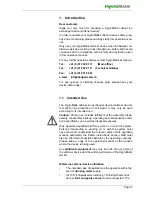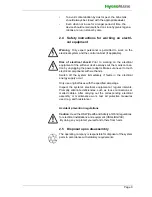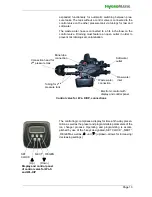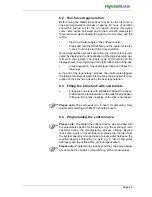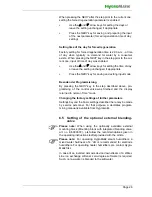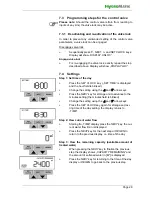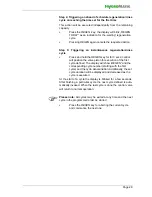
Page 15
Please note:
The dimensioning of the WaterLine softener
device must be such that soft water demand does not exceed
the soft water capacity between any two regenerations.
The regeneration process is separated in the partial steps „back-
wash“, „brine/slow wash“, „rinse “ and „fill“.
4.4.2.1 Backwash
Under control valve regime raw water is fed bottom up through
the exchanger resin in the pressure tank, thus causing disaggre-
gation of the resin.
4.4.2.2 Brine and slow wash
In the brine tank, a 25 percent brine is prepared from raw water
and NaCl.
Please note:
Building up the required brine concentration takes
6 hours of time minimum. Such, any two regenerations should
be separated by at least this time interval.
Brine is sucked up by the control valve injector and blended with
raw water to a 10 to 12 percent concentration, which is the opti-
mum concentration for the regeneration process. The diluted
brine is fed through the resin top down. Now ion exchange takes
place in the inverted direction as compared to softening, setting
free and draining calcium- and magnesium ions bonded by the
resin. Following brining, slow wash is carried out in the follow-
ing way: When no more brine is sucked by the injector, only raw
water flows through the resin bed in the pressure tank. Any brine
left in the pressure tank is swamped out by and by.
4.4.2.3 Rinse
Following slow wash, rinse is carried out with raw water guided
through the pressure tank top down at a rate of approx. 8 - 12 m/
h. After a flushed water volume corresponding to 3 to 4 times the
resin filling volume, proper soft water may again be produced.
4.4.2.4 Fill
The brine tank is filled-up automatically with a defined volume of
watert. After filling the regeneration prozess is terminated and
the control valve sets the WaterLine softener device back to nor-
mal operation.
Backwash
Raw water
Brine and
slow wash
Brine
Raw water
Rinse
Raw water
Summary of Contents for WaterLine Double
Page 43: ...Page 43 This page intentionally left blank ...
Page 44: ......





